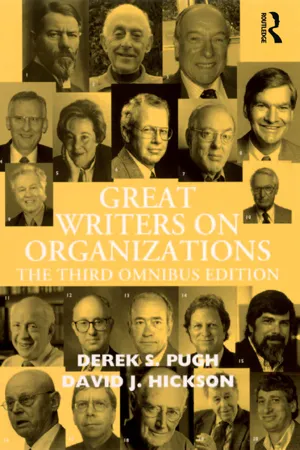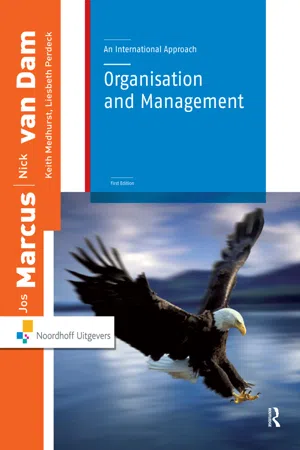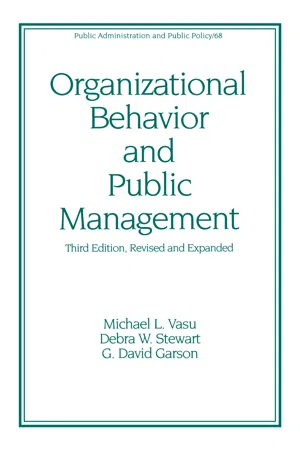Business
Taylor Motivation Theory
The Taylor Motivation Theory, developed by Frederick Taylor, emphasizes the role of monetary incentives in motivating employees to increase productivity. It suggests that workers are primarily motivated by financial rewards and that their performance can be improved through a system of rewards and punishments. The theory focuses on the concept of "scientific management" to optimize efficiency and productivity in the workplace.
Written by Perlego with AI-assistance
Related key terms
9 Key excerpts on "Taylor Motivation Theory"
- eBook - ePub
Performance Management
Measure and Improve The Effectiveness of Your Employees
- (Author)
- 0(Publication Date)
- Harvard Business Review Press(Publisher)
A business was conceptualized as a machine for producing goods and services, and people were simply among the parts of that machine. Frederick Taylor (1856–1915), credited as the father of scientific management, defined work in terms of coordinated, highly specified tasks designed for optimal efficiency, with little or nothing left to the judgment of production-line employees. This approach to work was supported by a particular view of human nature—or, should we say, the nature of industrial workers. In this view, employees were lazy and untrustworthy creatures. They could be motivated only by pay and the fear of dismissal and unemployment. Years later, Douglas McGregor would enshrine this view of human nature in what he called the Theory X approach to management. 1 Managers who embrace Theory X have two motivational tools: the carrot and the stick—greed and fear. The Theory X work environment is characterized, as you’d imagine, by lots of prodding by the boss, tight control over employee work, and narrowly specified jobs. The first chink in the armor of Theory X was exposed through experiments conducted during the 1920s by Elton Mayo at the Hawthorne Works, a Western Electric assembly plant in northern Illinois. Mayo hoped to determine the negative effects of fatigue, monotony, and unpleasant working conditions on job productivity and how these effects could be controlled or neutralized through improved lighting, more frequent rest breaks, different work hours, temperature, and other environmental factors. Using a control group of employees, he made frequent changes in their working conditions—pay, lighting levels, rest breaks, and so forth—always explaining his changes in advance. Productivity improved, but to Mayo’s surprise, the improvements appeared to be independent of working conditions. He concluded that the workers performed better because management had demonstrated an interest in such improvements - eBook - ePub
Management Organization and Employment Strategy (RLE: Organizations)
New Directions in Theory and Practice
- Tony Watson(Author)
- 2013(Publication Date)
- Routledge(Publisher)
Babbage is probably best known as the deviser of the original computer and his work here is relevant to our claim that the philosophy underlying these ideas is one which sees people as machines. Part of the inspiration for Babbage's ‘calculating engine’ derived from his admiration of the way his fellow mathematicians in France had so speedily produced a series of mathematical tables. This had been done by identifying parts of the work that could be done by the less mathematically able staff and allocating it accordingly. The organisation of these tasks, thought Babbage, showed the way for the machines which would eventually replace people in this kind of work.The motivational theory behind all this is implicit and is crude. The economic context in which this kind of work is offered is a free market one. The individual is not dependent on any kind of feudal lord or on the state. To survive he or she has to sell their capacity to work for the best price they can get. In the laissez-faire world implied by these principles of job design, one works to avoid hunger. And the extent to which one's hunger is assuaged depends on what quality of labour capacity one has to sell.Taylorism
Taylorism or Scientific Management represents a further syste-matisation of emerging ideas of rationalised work effort. The basic principles laid down by Taylor and his fellow systematisers were examined earlier (pp. 49–51) but there are several points which need to be added in the present context. The earlier advocates of work specialisation did not have a great deal to say about how the work was to be ‘managed’ or about ‘leadership’ and ‘rewards’. As Craig Littler (1982) puts it, earlier theorists like Babbage had ‘no clear idea of the problems of, and the means of, re-integration of the fragmented job roles’. To manage the fragmented work, therefore, the managers would ensure that all the planning and allocation work was done by themselves, that all work would be monitored and allocated times and that a payment-by-results system would be introduced to motivate the workers to apply themselves to maximum effect in terms of output.Leadership under Taylorism is a matter of applying science, and motivation is a matter of offering a financial return commensurate with the steady application of effort to the tasks designed by the managers. Workers are like machines, both in the manner they are required to work and in the way they are ‘fed’ with cash in proportion to their output – just as a motor is fed with petrol in proportion to the mileage it covers. - eBook - ePub
Reward Management
Alternatives, Consequences and Contexts
- Sarah Jones, Stephen J Perkins(Authors)
- 2024(Publication Date)
- CIPD - Kogan Page(Publisher)
He advocates attention to contingencies. In linking with strategy, it is necessary to be able to theorise when HRM matters most in achieving business goals. For example, service sector business environments may require a greater strategic emphasis on HRM factors. As previously indicated, the accent is on alignment at both the vertical and horizontal levels – that is, between people management and corporate goals, and between the elements of HRM policy and practice, reflecting holistic systems thinking. (We explore these issues in detail in Chapter 12.) The ‘traditional’ managerial approach to motivating workers may be described as fear of punishment. However, such an orientation has tended to be associated with work relationships based on some sort of mutual obligation between the parties, as under feudalism, for example. Emerging in the era of late industrialisation, ‘scientific management’ may be perceived as a critique of inefficient managerial organisation rather than of the workforce. Taylorism is complemented by a moral view that fair treatment of workers will (and should) be achieved by specifying precisely what tasks are to be performed, and how they are to be performed, and training the workforce accordingly. Reward is to be tied to task/output attainment, provided this is exactly in accordance with managerial specifications. It is an open question as to how theory informing scientific management may be extended to help explain the reward implications of AI-worker interaction in emerging white collar techno workplaces. In contrast with economics-based motivation under scientific management theory, what became known as the ‘human relations’ school of thought, popularised by Elton Mayo (1945), adopts a more holistic view of the person performing a job. The source of employee satisfaction derives from the social relations surrounding work - eBook - ePub
Great Writers on Organizations
The Third Omnibus Edition
- Derek S. Pugh, David J. Hickson(Authors)
- 2016(Publication Date)
- Routledge(Publisher)
He suggests three causes: first, the fallacious belief of the workers that any increase in output will inevitably result in unemployment; second, defective systems of management which make it necessary for workers to restrict output in order to protect their interests (‘systematic soldiering’); third, inefficient rule-of-thumb, effort-wasting methods of work. Taylor conceived it to be the aim of scientific management to overcome these obstacles. This could be achieved by a systematic study of work to discover the most efficient methods of performing the job, and then a systematic study of management leading to the most efficient methods of controlling the workers. This would bring a great increase in efficiency and with it prosperity to the benefit of all, since a highly efficient prosperous business would be in a much better position to ensure the continuing well-paid employment of its workers. As Taylor put it: ‘What the workmen want from their employers beyond anything else is high wages and what employers want from their workmen most of all is low labour cost of manufacture … the existence or absence of these two elements forms the best index to either good or bad management.’To achieve this Taylor lays down four ‘great underlying principles of management’:1. THE DEVELOPMENT OF A TRUE SCIENCE OF WORK
He points out that we do not really know what constitutes a fair day’s work; a boss therefore has unlimited opportunities for complaining about workers’ inadequacies, and workers never really know what is expected of them. This can be remedied by the establishment after scientific investigation of a ‘large daily task’ as the amount to be done by a suitable worker under optimum conditions. For this they would receive a high rate of pay – much higher than the average worker would receive in ‘unscientific’ factories. They would also suffer a loss of income if they failed to achieve this performance.2. THE SCIENTIFIC SELECTION AND PROGRESSIVE DEVELOPMENT OF THE WORKER
To earn this high rate of pay workers would have to be scientifically selected to ensure that they possess the physical and intellectual qualities to enable them to achieve the output required. Then they must be systematically trained to be ‘first class’. Taylor believes that every worker could be first class at some job. It was the responsibility of management to develop workers, offering them opportunities for advancement which would finally enable them to do ‘the highest, most interesting and most profitable class of work’ for which they could become first class. - eBook - ePub
Organization and Management
An International Approach
- Nick van Dam, Jos Marcus(Authors)
- 2019(Publication Date)
- Routledge(Publisher)
In the 18th century, pioneers developed the pressurised coal-fired steam engine, making mass production in large factories possible and replacing manufacture of products in workers’ homes or in small workplaces. The explosive growth of factories attracted large numbers of workers from the countryside. As a consequence, Western society changed from an agricultural to an industrial one. In the larger cities, the growing working classes lived in poorly built workers’ houses. The pay was low and living conditions miserable. This development began in England, then after 1840, it spread across Western Europe and the United States.By the end of the 19th century, American companies had grown dramatically in response to the ever-expanding consumer market. By now, the existing controls and checks were inadequate. The division of responsibility between supervisors and staff was unclear, production standards and wages were determined subjectively and an air of unpredictability prevailed. There was hardly any planning. The managers tried to push the workers to produce as much as possible, often using harsh methods. The workers reacted in an organised way by systematically stretching out their time.In such a situation, there was clearly a need for a more structured and systematic approach. The man who saw this and decided to do something about it was the engineer Frederick Winslow Taylor (1856–1915). With his publications and lectures, he laid the ground for what we now call scientific management.1.6 Frederick Taylor and scientific management (± 1900)Frederick Taylor was the first to suggest a systematic, coherent approach to determine the manner in which factories should be organised. Rather than the manager as slave driver, it was proposed that a broader view should be adopted, allowing the manager to focus on planning, coordinating and overseeing, and checking of results.Frederick TaylorKey elements that have grown out of Taylor’s theory of management of organisations (scientific management) are:Scientific management- Scientific analysis of the activities that should be carried out and the time and motion studies to be used. (The results can be used to standardise and normalise the production process and the machines and materials used.)
- Clear division of tasks and training for the workforce so that each task and operation can be precisely identified and allocated. This results in worker routines, leading to an improvement in production.
- Bernard S. Katz, Ronald E. Robbins, Bernard S. Katz, Ronald E. Robbins(Authors)
- 2017(Publication Date)
- Routledge(Publisher)
The Degradation of Work in the Twentieth Century, is taken up largely with a bitter critique of the Taylorian gospel. Scientific management is also out of favor with many business school professors. Some corporate executives have even become disenchanged to the point of supporting heretical experiments in the organization of work on non-Taylorian lines. In the United States and Europe, notably in Norway and Sweden, workers have been grouped into teams whose members are freed from the tyranny of time-and-motion studies and are permitted to arrange among themselves how best, for example to put together an automatic transmission.But most factory managers and industrial engineers, in Russia and the socialist countries of Eastern Europe as well as in the noncommunist world, are inclined to look on such experiments as softheaded so-goodism. By and large, Taylor’s truth is still mighty and prevails. Indeed, as Peter Drucker, a leading student of business management, has suggested, scientific management “may well be the most powerful as well as the most lasting contribution America has made to Western thought since the Federalist Papers.”Frederick Taylor was born in Germantown, on the outskirts of Philadelphia, in 1856, and very early in life displayed two closely related traits that were strongly to mark his career. According to his admiring biographer, Frank Barkley Copley, these were “a passion for improving and reforming things,” and “a divine discontent with anything short of the one best way.” “Even a game of croquet was a source of study and careful analysis with Fred,” a boyhood friend recalled years later, adding that, on cross-country tramps, Taylor “was constantly experimenting with his legs” to discover the most efficient method of walking.Taylor grew up in easy circumstances, his father having come into enough money as a young man so that he could give up the practice of law and devote himself to reading poetry and the classics, and performing good works. In his teens young Fred Taylor traveled in Europe with his family for three years, during which he briefly attended schools in Germany and France. Later he went to Exeter, where he captained the base-ball team and, in his senior year, ranked first in his class. He had planned to go to Harvard and, eventually, to become a lawyer. Instead, for reasons that are obscure--Taylor himself used to speak unconvincingly of a need to rest his eyes after too much night study at Exeter--he went to work as an apprentice pattern-maker and machinist in a small Philadelphia pump factory. He stayed there four years, leading a double life as machine-shop hand by day and a proper Philadelphian by night. He belonged to the Young America Cricket Club, sang in a choral society, acted in amateur theatricals--he was particularly admired for his skill in impersonating young women--and went to dances where he discharged his debt to Philadelphia society by choosing half (but no more) of his partners from a group of wallflowers whose names he had listed for himself in advance.- eBook - ePub
Performance Management Systems
A Global Perspective
- Arup Varma, Pawan S. Budhwar, Angelo DeNisi, Arup Varma, Pawan S. Budhwar, Angelo DeNisi(Authors)
- 2023(Publication Date)
- Routledge(Publisher)
Van Iddekinge, Aguinis, Mackey, & DeOrtentiis, 2018 ). Given the importance of employee motivation, it is critical for managers to understand and apply motivation theories so as to implement the performance management system effectively.In this chapter, we first introduce several relevant theories of work motivation that we then develop the overall motivation model from. We then elaborate on how organizations and managers can use motivation theories to enhance employee motivation and productivity through performance management. We conclude with a case study to help readers apply the knowledge covered in this chapter.Theories of Work Motivation
Need-Based Theories of Work Motivation
A need is “a hypothetical concept which stands for a force … in the brain region, a force which organizes perception, apperception, intellection, conation and action in such a way as to transform in a certain direction an existing unsatisfying situation” (Murray, 1938 , pp. 124–125). This definition highlights that a need is a hypothetical entity that drives people’s attitudes and behaviors. Indeed, the earliest theories of motivation were developed to understand what employees need, and how to motivate employees to work hard by fulfilling their needs. Maslow’s hierarchy of needs, Alderfer’s ERG model, Herzberg’s motivation-hygiene theory, and McClelland’s three needs theory, as well as self-determination theory, are all notably examples of needs-based theories of work motivation.Maslow’s hierarchy of needs is based on the assumption that human needs are ranked hierarchically, from the most basic needs—physiological needs—to safety needs, social needs, esteem needs, and, finally, the highest level of the hierarchy, the need for self-actualization (Maslow, 1943 , 1954 ). Physiological needs include needs for food, drink, shelter, and sleep. Organizations can help fulfill employees’ physiological needs by providing a base salary, reasonable work hours, and a comfortable physical workspace (Schermerhorn, 2001 ). Safety needs include the needs for security and freedom from fear, pain, and danger. Employers may fulfill employees’ safety needs by offering fringe benefits and job security, as well as ensuring a safe work environment (Schermerhorn, 2001 ). Social needs represent one’s desire to be accepted and loved by others. Needs for friendship, intimacy, and attachment are examples of social needs. Team activities, pleasant supervisors, and interactions with clients can help satisfy employees’ social needs in the workplace (Schermerhorn, 2001 ). Esteem needs represent one’s desire for a positive self-image, as well as respect and recognition from others. Employees’ esteem needs can be fulfilled when employers appreciate their efforts, provide promotion opportunities, and/or delegate them more responsibilities and authority (Schermerhorn, 2001 - eBook - ePub
Manufacturing Ideology
Scientific Management in Twentieth-Century Japan
- William M. Tsutsui(Author)
- 2001(Publication Date)
- Princeton University Press(Publisher)
Despite its quiet reception on the shop floor, however, the introduction of Scientific Management did not go unchallenged in Japan. Academics and labor experts were not nearly as muted in their reaction to Taylorism as the factory workers who experienced managerial restructuring firsthand. Four aspects of the new system—its effects on individual workers, its implications for the labor movement, its social consequences, and its claims to be scientific—attracted the most attention from Japanese intellectuals in the 1910s and 1920s.On the first count, Scientific Management’s detractors argued that the new American methods ignored the physiological limitations and psychological needs of the laborer, leading unavoidably to the degradation of work and the redoubling of capitalist exploitation. According to Morito Tatsuo, the noted Marxist economist, Taylorism was a “method for squeezing the utmost efficiency from workers under the guise of ‘harmony’ and ‘science.’”100 Standardization, specialization, and the concentration of technical skills in management were purported to deskill and dehumanize, Taylorism’s “theft from the laborers of their knowledge and their experience” leading to a loss of worker autonomy and an enhancement of managerial control over the production process.101 “Artisans,” social commentator Hosoi Wakizō mourned, “have lost forever the joy of creation.”102 With the employers’ ability to “drive” workers thus intensified and with work made increasingly tedious by simplification and detailed motion study, critics charged, overwork became the norm and workers were ever more hindered by physical and mental fatigue.103 The Taylorite future was painted as one of physical degradation and grinding monotony. Horie Kiichi saw “the human being [becoming] just another machine, with no sense of purpose, no powers of imagination or invention, untiringly performing its alloted work, knowing nothing else.”104 As one observer aptly noted, Taylorism “overlooks completely those aspects of ‘human nature’ that cannot be quantified or predicted.”105 - Michael L. Vasu, Debra W. Stewart, G. David Garson, Michael L. Vasu, Debra W. Stewart, G. David Garson(Authors)
- 2017(Publication Date)
- Routledge(Publisher)
Behavior needs to be tied to reinforces. These reinforcers may be symbolic, explicit praise, or tangible pay for specific levels of measured performance.Motivation in the Workplace
The preceding review of basic motivation theory provides the conceptual building blocks for models predicting and analyzing motivation on the job. Like the theories of motivation put forth above, research on employee motivation falls into two broad categories: (1) research focusing on how changes occurring in the worker yield changes in behavior (rooted in cognitive theory): and (2) research asking how reinforcement of behavior itself yields changed behavior (rooted in acognitive theory). Each of the approaches in the cognitive tradition gives rise to distinctive prescriptive models for motivating employees.Applications Deriving from the Cognitive Tradition
Theory X, Theory Y, Theory Z
The first model stemming from the human growth development approach is the previously mentioned Theory X, Theory Y analysis of motivation by Douglas McGregor. Douglas McGregor, in his classic work, The Human Side of Enterprise (1957), builds a theory of work motivation premised on the humanistic psychology of Abraham Maslow.There are at least five sets of goals which we may call basic needs. These basic goals are related to each other, being arranged in a hierarchy of prepotency. When a need is fairly well satisfied, the next prepotent (“higher”) need emerges, in turn to dominate the conscious life and to serve as the center of organization of behavior, since gratified needs are not active motivators (Maslow, 1943).Accepting this analysis of human nature with needs arranged from physiological, to safety, to social, to ego, to self-actualization in ascending order of potency, McGregor criticizes conventional managerial theory for making incorrect assumptions about the management process. According to McGregor, conventional management theory, or Theory X, believes that without active intervention by management, people would be passive, even resistant, to organizational needs. Theory X sees the average person as indolent by nature, lacking ambition, disliking responsibility, and preferring to be led. The typical employee is inherently self-centered, indifferent to organizational needs and by nature resistant to change (McGregor, 1957). In effect, they are at best motivated by the lower levels of the needs hierarchy. McGregor argues that the Theory X philosophy confuses cause and effect in its analysis of human nature. If the employee in the modern organization is the passive indifferent actor described above, it is in response to existing management philosophy, policy, and practice. He is “sick” because of deprivation of a higher level need. This sickness has the behavioral consequences outlined above. While the contemporary organization meets the physiological and safety needs of most employees, social needs are viewed by management as a threat to the organization so the organization seeks to inhibit them.
Index pages curate the most relevant extracts from our library of academic textbooks. They’ve been created using an in-house natural language model (NLM), each adding context and meaning to key research topics.








